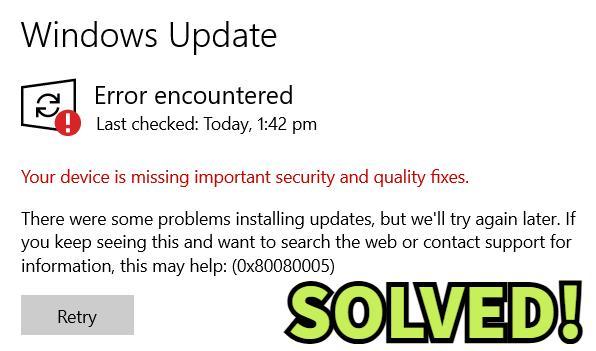When you update Windows, a normal procedure can transform into failure displaying a 0x80080005 error which halts the update. The system ends up out of date and exposed to security risks because of this. But why this issue arises and how does one resolve it? This article examines the reasons behind Windows update error code 0x80080005 along with disclosing 8 solutions for its resolution.
Part 1: Overview of Windows Update Error 0x80080005
The Windows Update error 0x80080005 emerges during the installation of updates on the Windows 10/11 platform when the process faces an interruption. When this error occurs your system can’t receive updates crucial for its security and performance. You might come across this glitch because of the following reasons:
- File Restrictions – Some files may be blocked which could prevent updates.
- Startup Issues – Wrong startup settings can conflict with updates.
- Software Conflicts – Some apps may clash with Windows Update.
- Corrupt System Files – Damaged files can cause update failures.
- Malware – Viruses may interrupt the update process.
Bonus Tip: How to Recover Data Lost Due to a Windows Update?
As we mentioned earlier, the malfunction of system files produces Windows update failures that ultimately result in system instability. Addressing this problem could force you to perform a system reset although such measures often result in data loss. Therefore, you must extract it first before proceeding to reset your system.
In that regard, tools like Tenorshare 4DDiG can help. This free data recovery tool returns files that disappear due to error 0x80080005 on Windows 10/11, system breakdowns, boot problems, or virus infections. The app also provides additional features besides the main functionality. Using this special file retrieval application provides multiple advantages that you should know about such as:
- This application allows users to recover files that have been damaged or restore data that was either deleted or formatted.
- The program enables users to retrieve 2000 different kinds of files including audio files along with videos, documents, archived data, and image files.
- The software enables users to recover files from multiple external/internal devices.
- This tool offers 2GB of free recovery and preview of files.
- Non-tech users will find it much easier to navigate than other recovery tools.
Here’s how to use this file recovery tool to reclaim files missing due to a 0x80080005 error:
Step 1: Execute the file recovery tool on your computer. Then, choose the drive from where you lost the files. Pick the file types to scan. Then, hit “Scan.”
Step 2: After the scan commences wait for it to extract the exact files you wish to reclaim. Then, pause or stop the scan and preview them by their path or type.
Step 3: Hit “Recover.” This will send the reclaimed files to your desired location e.g. on your computer or cloud drive.
Part 2: How Do I Fix Windows Update Error 0x80080005?
The following 8 methods address Windows Update error code 0x80080005 based on different conditions. So, pick a solution that functions best according to your situation:
Method 1: Run Windows Update Troubleshooter
By executing the Windows Update Troubleshooter on your computer you can find and fix the faults that cause the Windows Update error 0x80080005. The tool addresses setting misconfigurations while fixing damaged files and software dilemmas that prevent update downloads. Moreover, the tool can also detect software programs that block update processes. Here’s how to fix error code 0x80080005 by executing Windows Update Troubleshooter:
Step 1: Click the right mouse button on “Windows Start.” Then, choose “Settings.
Step 2: Tap “Windows Update.” Next, head to “Troubleshoot. After this, select “Additional troubleshooters.”
Step 3: Click “Windows Update.” Then, hit “Run the troubleshooter.” It will automatically identify problems and resolve them.
Method 2: Check For Corrupted System Files (Run SFC and DISM)
Windows-embedded tools like SFC and DISM can fix error 0x80080005 when system file corruption generates this error. SFC scans and replaces damaged files, while DISM restores Windows image health if SFC can’t fix issues. Both of these tools also resolve update component errors, helping Windows Update run smoothly. Here’s how to fix error code 0x80080005 with SFC and DISM:
Step 1: Input “cmd.” Do this in the Windows search field. Open “Command Prompt.”
Step 2: Type the following command. Hit “Enter” afterward:
- sfc /scannow
Step 3: To execute DISM follow “Step 1 to 2” and then, input the following command. Hit “Enter” afterward:
- DISM /Online /Cleanup-Image /CheckHealth
Method 3: Switch Off Antivirus Software Temporarily
Sometimes the update process gets interrupted because antivirus programs tend to identify updates as security threats. But you can resolve 0x80080005 on Windows 10/11 by switching off the antivirus which will allow the updates to install without a hitch. Here’s how to do that:
Step 1: Click the right mouse button on “Windows Start.” Then, choose “Settings.
Step 2: Select “Update & Security.” Next, tap “Windows Security.”
Step 3: After this, open “Virus & threat protection”. Beneath “Virus & threat protection settings” hit “Manage settings.”
Step 4: Switch off “Real-time protection.”
Method 4: Use Windows Update Assistant
Another way to resolve Windows Update error 0x80080005 is through Windows Update Assistant. An official tool from Microsoft it can manually force install updates and bypass automatic update issues. The tool also ascertains all necessary updates, including drivers, are installed for system stability. Here’s how to fix error code 0x80080005 with Windows Update Assistant:
Step 1: Acquire the Windows Update Assistant for your Windows 10/11 computer.
Step 2: Then, execute it. Next, click “Update Now.”
Step 3: After this, follow the instructions that will finish the update procedure. Then, restart your PC. Verify whether the error code 0x80080005 remains resolved.
Method 5: Carry Out a Clean Boot
If the error 0x80080005 on Windows 10/11 is caused by software conflicts or some running processes a clean boot will execute only crucial services. It isolates problematic programs, making it easier to find the cause. With fewer background apps, the update process runs more smoothly. Follow the instructions below to carry out a clean boot:
Step 1: Hit and hold the “Win + R” keys. This will open the “Run” dialog. Then, type “msconfig.” Hit “Enter.”
Step 2: Beneath the “Services” tab, tickmark “Hide all Microsoft services.” Then, click “Disable all.”
Step 3: You can open the “Task Manager” interface by pressing “Ctrl + Shift + Esc” at the same time. After this, head to “Startup.” Disable unnecessary apps.
Step 4: Reboot. Then, execute Windows Update again.
Method 6: Take Ownership of the System Volume Information Directory
The System Volume Information folder remains crucial for Windows updates and if you’re denied access to it, this can generate error code 0x80080005. However, granting yourself ownership of this folder will restore update functionality. Here’s how to do that:
Step 1: Input “cmd.” Do this in the Windows search field. Open “Command Prompt.”
Step 2: Type the following command. Hit “Enter” afterward:
- cmd.exe /c takeown /f “C:\System Volume Information\*” /R /D Y && icacls “C:\System Volume Information\*” /grant:R SYSTEM:F /T /C /L
Method 7: Reset Windows Update Components
With time, Windows Update components either become corrupted or develop misconfigurations causing a malfunction like 0x80080005. Resetting them can resolve this malfunction because it restores your operating system to its factory settings and erases all corrupt files. Check out the following steps to reset Windows Update components:
Step 1: Input “cmd.” Do this in the Windows search field. Open “Command Prompt.”
Step 2: Type the following commands to stop the update services in order to safely adjust settings. Hit “Enter” after each one:
- net stop wuauserv
- net stop cryptSvc
- net stop bits
- net stop msiserver
Step 3: Type the following commands to rename update folders. Renaming them will clear possible corruption and allow Windows to create fresh folders. Hit “Enter” after each one:
- ren C:\Windows\SoftwareDistribution SoftwareDistribution.old
- ren C:\Windows\System32\catroot2 Catroot2.old
Step 4: Type the following commands to restart update services. Hit “Enter” after each one:
- net start wuauserv
- net start cryptSvc
- net start bits
- net start msiserver
Step 5: Reboot. Then, execute Windows Update again.
Method 8: Reset Windows
When all else fails to resolve the 0x80080005 glitch, reset your Windows. This will restore system integrity and repair corrupted system files. It also removes conflicting apps, clears unnecessary clutter, and resets settings to default. Follow the instructions beneath to reset your Windows:
Step 1: Click the right mouse button on “Windows Start.” Then, choose “Settings.
Step 2: Select “Update & Security.” Next, pick “Recovery.”
Step 3: Afterward, tap “Reset this PC.” Hit “Get Started.”
Step 4: Choose between “Keep my files” (to keep personal data) or “Remove everything” (for a full reset).
Step 5: Hit “Cloud download” to directly reinstall Windows from Microsoft’s server.
Bottom Line
The 0x80080005 Windows Update failure blocks necessary security updates which creates vulnerabilities to system threats. Though this error can be repaired by executing the Update Troubleshooter, turning off the antivirus, resetting update components, and performing a clean boot.
But if all these solutions fail to resolve the update malfunction, reset your Windows. But be sure to retrieve your data first with 4DDiG Data Recovery. It can extract removed, hidden, missing, formatted or corrupted files from various storage devices with high success.



































